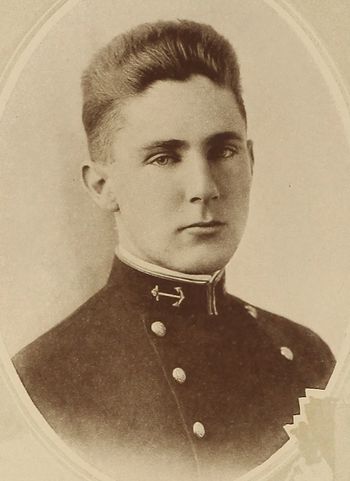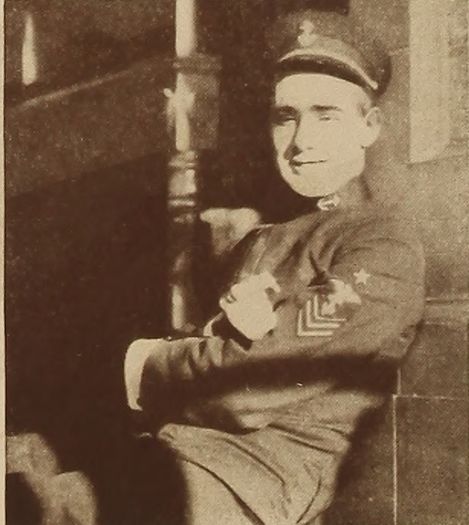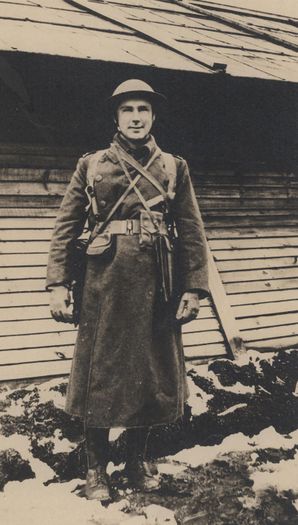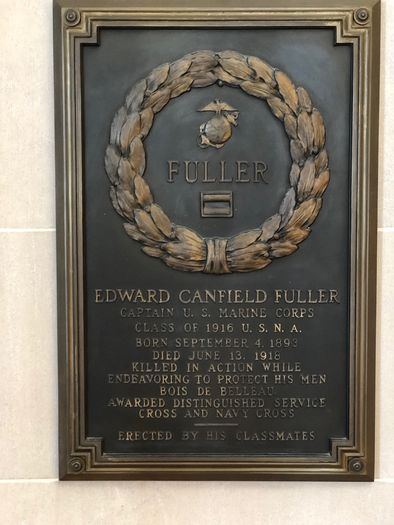EDWARD C. FULLER, CAPT, USMC
Edward Fuller '16
Lucky Bag
From the 1916 Lucky Bag:
Edward Canfield Fuller
Hamilton, Virginia
"Ted"
HERE we have a man with not only a reputation, but with many reputations. He wears white flannels and pumps in mid-winter for one thing. Need we say more?
Ted had to quit prepping and answer the call of the greatest American game (baseball)—then he fooled us all and passed. On July 12th he and Mick started life anew together. After a few weeks of pronubial bliss, the authorities suggested the separation of the pair. Ted bilged Pal and tried to bilge himself, but fortune smiled—or frowned and E. C. still wears the dear old uniform—yes, the same one.
Teddie is a good scout, in spite of the fact that he is a "Junior," and the greatness of his heart is shown by his toleration of the crew which hung around his home. They over-ran his house, so that an honest man could find seclusion nowhere. Reticence is one of Edward's salient qualities, and it all seems due to lack of inspiration. Turn him loose outside in shallow waters and the Colonel's boy is at once the soul of Oriental repartee and sparkling wit. The Café Regina and the clubs of London have all heard his scintillating conversation and marveled that the man should have so many farads. Ted should have been in the Old Navy. His trend is toward the old regime, and he is lost in these arid surroundings—the South had no harder time after the Emancipation than Teddy does trying to treat scurvy Plebes as equals—Plebes are bad enough but pale-faced "cits" are the abomination of his life. Ask him about eight of them that came from Washington to call—while he inspected the limousine.
Incidentally, he won't go to China right away.
"Better marry me now while I have the money."
Buzzard; Baseball Squad [3, 2, I); Baseball Numerals.

Edward Canfield Fuller
Hamilton, Virginia
"Ted"
HERE we have a man with not only a reputation, but with many reputations. He wears white flannels and pumps in mid-winter for one thing. Need we say more?
Ted had to quit prepping and answer the call of the greatest American game (baseball)—then he fooled us all and passed. On July 12th he and Mick started life anew together. After a few weeks of pronubial bliss, the authorities suggested the separation of the pair. Ted bilged Pal and tried to bilge himself, but fortune smiled—or frowned and E. C. still wears the dear old uniform—yes, the same one.
Teddie is a good scout, in spite of the fact that he is a "Junior," and the greatness of his heart is shown by his toleration of the crew which hung around his home. They over-ran his house, so that an honest man could find seclusion nowhere. Reticence is one of Edward's salient qualities, and it all seems due to lack of inspiration. Turn him loose outside in shallow waters and the Colonel's boy is at once the soul of Oriental repartee and sparkling wit. The Café Regina and the clubs of London have all heard his scintillating conversation and marveled that the man should have so many farads. Ted should have been in the Old Navy. His trend is toward the old regime, and he is lost in these arid surroundings—the South had no harder time after the Emancipation than Teddy does trying to treat scurvy Plebes as equals—Plebes are bad enough but pale-faced "cits" are the abomination of his life. Ask him about eight of them that came from Washington to call—while he inspected the limousine.
Incidentally, he won't go to China right away.
"Better marry me now while I have the money."
Buzzard; Baseball Squad [3, 2, I); Baseball Numerals.
Loss
Edward was lost (probably on June 13, 1918; see below) during the Battle of Belleau Wood. He was commanding officer of the 75th Company, 1st Battalion, 6th Marine Regiment, 4th Marine Brigade, 2nd Infantry Division, American Expeditionary Forces.
Other Information
From researcher Kathy Franz:
Edward departed for France with the first contingent of marines under Col. Doyen in June, 1917. He was adjutant to Col. John Myers, and then he received command of a company.
Per The Baltimore Sun on July 2, 1918 via Kathy Franz:
Captain Fuller fell leading his troops in battle. Writing to his father, Colonel Fuller, Major H. M. Smith, young Fuller’s commanding officer, said: “The Germans were attacking him strongly, but he fought them to a standstill and drove them back. Ted was holding a part of the Bois de Boileu with his company, and largely through his efforts the attack was frustrated. Men who were on the spot speak of it as a magnificent display of courage. The boy did a glorious death – killed by shell fire.
Edward was survived by his parents and sister. He is buried in the Naval Academy Cemetery. (Edward's father, Ben Fuller, later became the 15th Commandant of the Marine Corps.)
Distinguished Service Cross
From Hall of Valor:
The President of the United States of America, authorized by Act of Congress, July 9, 1918, takes pride in presenting the Distinguished Service Cross (Posthumously) to Captain Edward Canfield Fuller (MCSN: 0-2395), United States Marine Corps, for extraordinary heroism while serving with the Sixth Regiment (Marines), 2d Division, A.E.F., in action in the attack on Bois-de-Belleau, France, 12 June 1918. While fearlessly exposing himself in an artillery barrage for the purpose of getting his men into a position of security in the attack on Bois-de-Belleau, Captain Fuller was killed and thereby gave his life in an effort to protect his men.
General Orders: War Department, General Orders No. 99 (1919)
Service: Marine Corps
Division: 2d Division, American Expeditionary Forces
From Hall of Valor:
The President of the United States of America takes pride in presenting the Navy Cross (Posthumously) to Captain Edward Canfield Fuller (MCSN: 0-2395), United States Marine Corps, for extraordinary heroism while serving with the 6th Regiment (Marines), 2d Division, A.E.F. in action in the attack on Bois-de-Belleau, France, 12 June 1918. While fearlessly exposing himself in an artillery barrage for the purpose of getting his men into a position of security in the attack on Bois-de-Belleau, Captain Fuller was killed and thereby gave his life in an effort to protect his men.
Service: Marine Corps
Division: 2d Division, American Expeditionary Forces
Silver Star
From Hall of Valor:
By direction of the President, under the provisions of the act of Congress approved July 9, 1918 (Bul. No. 43, W.D., 1918), Captain Edward Canfield Fuller (MCSN: 0-2395), United States Marine Corps, is cited (Posthumously) by the Commanding General, American Expeditionary Forces, for gallantry in action and a silver star may be placed upon the ribbon of the Victory Medals awarded him. Captain Fuller distinguished himself while serving with the Sixth Regiment (Marines), 2d Division, American Expeditionary Forces at Chateau-Thierry, France, 6 June to 10 July 1918.
General Orders: Citation Orders, 2d Division, American Expeditionary Forces
Service: Marine Corps
Division: 2d Division, American Expeditionary Forces
Rank: Captain
Photographs
From Flikr
The "Register of Commissioned and Warrant Officers of the United States Navy and Marine Corps" was published annually from 1815 through at least the 1970s; it provided rank, command or station, and occasionally billet until the beginning of World War II when command/station was no longer included. Scanned copies were reviewed and data entered from the mid-1840s through 1922, when more-frequent Navy Directories were available.
The Navy Directory was a publication that provided information on the command, billet, and rank of every active and retired naval officer. Single editions have been found online from January 1915 and March 1918, and then from three to six editions per year from 1923 through 1940; the final edition is from April 1941.
The entries in both series of documents are sometimes cryptic and confusing. They are often inconsistent, even within an edition, with the name of commands; this is especially true for aviation squadrons in the 1920s and early 1930s.
Alumni listed at the same command may or may not have had significant interactions; they could have shared a stateroom or workspace, stood many hours of watch together, or, especially at the larger commands, they might not have known each other at all. The information provides the opportunity to draw connections that are otherwise invisible, though, and gives a fuller view of the professional experiences of these alumni in Memorial Hall.
January 1917
March 1918
Namesakes
In July 1918, a Marine Corps training camp in Paoli, Pennsylvania, located on the grounds where the American Revolutionary War Battle of Paoli was fought, was named for him.
USS Fuller (DD 297) was also named for Edward.
Memorial
There is a plaque in Edward's honor in Memorial Hall.
Note
Most sources give June 12 as his date of death; this is what is in the award citations. However, his headstone gives June 13, and there is a report signed by him to his Battalion Commanding Officer on June 15.

The "category" links below lead to lists of related Honorees; use them to explore further the service and sacrifice of alumni in Memorial Hall.


